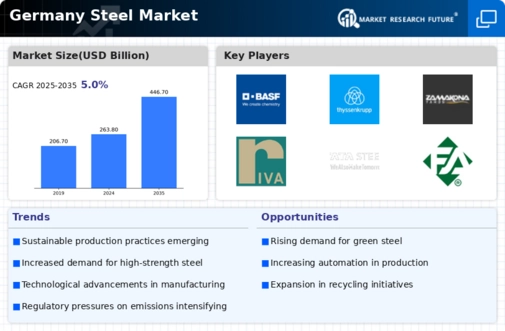The Germany Steel Market presents a robust competitive landscape characterized by a diverse range of players, advanced manufacturing technologies, and a significant focus on sustainability and innovation. Germany is known for its strong industrial base and high demand for steel, primarily driven by sectors such as automotive, construction, and engineering. The competitive dynamics of this market are shaped by several local and international companies that leverage unique strengths to capture market share.
The increasing emphasis on green technologies and the push toward reducing carbon emissions have triggered investments in research and development, leading to the introduction of novel steel products with enhanced properties. The competitive insights of this market reflect not only the operational efficiencies of the players but also their strategic partnerships, supply chain management, and responsiveness to market trends.BASF plays a significant role in the Germany Steel Market, bringing its vast experience in chemical production and solutions that enhance steel manufacturing processes.
The company stands out due to its innovative products that improve the performance of steel, such as additives that enhance corrosion resistance and mechanical properties. BASF's commitment to sustainability harmonizes well with the industry's shift towards greener practices, enabling it to establish strong partnerships with steel producers aiming for lower emissions and eco-friendly production methods.
Additionally, BASF's extensive research capabilities allow it to remain at the forefront of product development, validating its position as a pivotal contributor to the steel industry in Germany.Thyssenkrupp is another key player in the Germany Steel Market, known for its wide-ranging portfolio that includes high-quality flat and long steel products, as well as services that cater to various industries. The company has established a solid presence in the market through its commitment to innovation and customer-centric solutions. Thyssenkrupp's strengths lie in its ability to leverage cutting-edge technologies in steel production, enhancing both efficiency and product quality.
The company has been active in pursuing strategic mergers and acquisitions that align with its growth objectives, enabling it to expand its market footprint and enhance its service offerings. Key products like automotive steel, heavy plate, and clad products are designed to meet the specific needs of local clients, demonstrating Thyssenkrupp’s focus on developing tailored solutions for the German market. The combination of a comprehensive service range and a strong commitment to sustainability positions Thyssenkrupp favorably within the competitive landscape of the Germany Steel Market.
























Leave a Comment